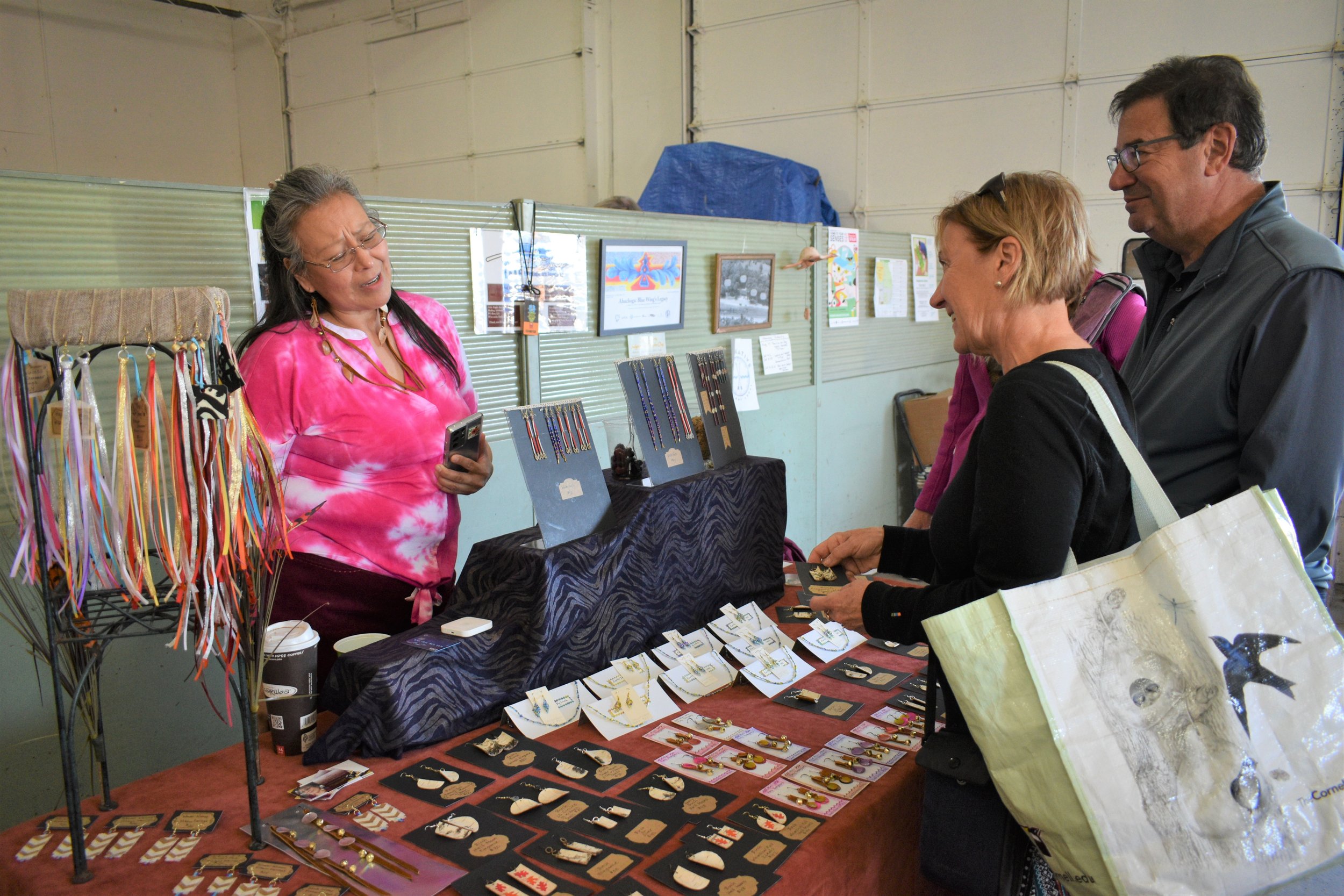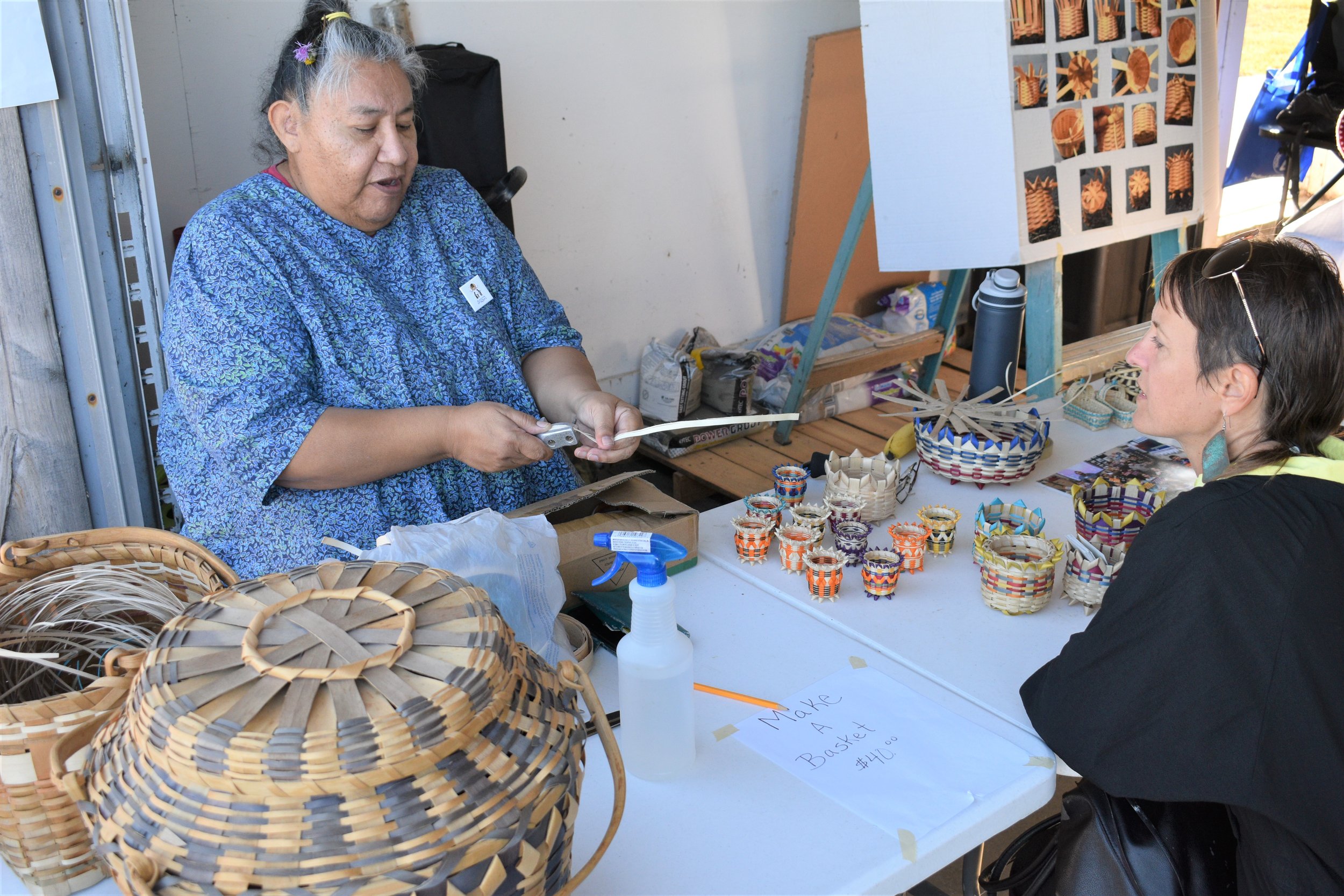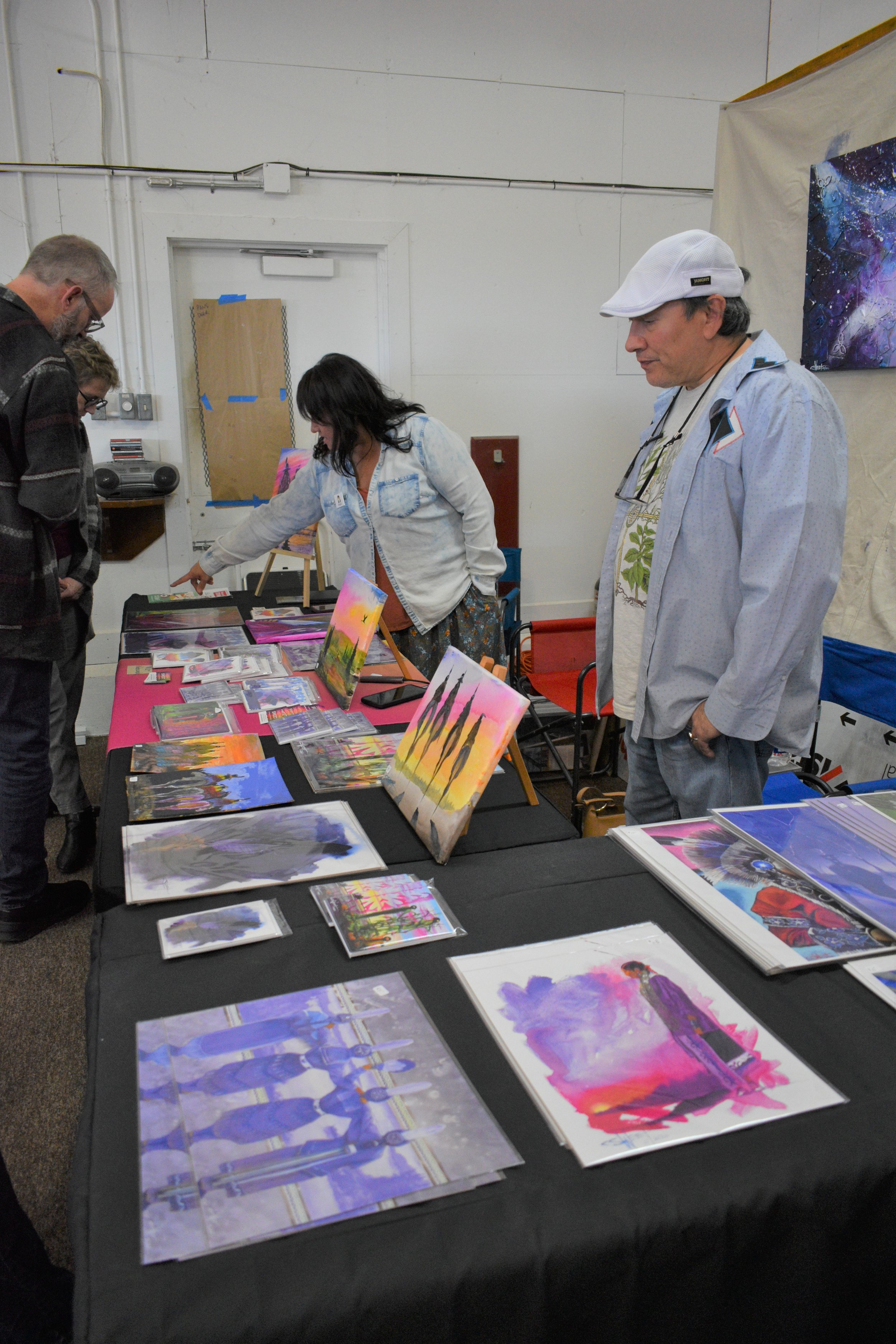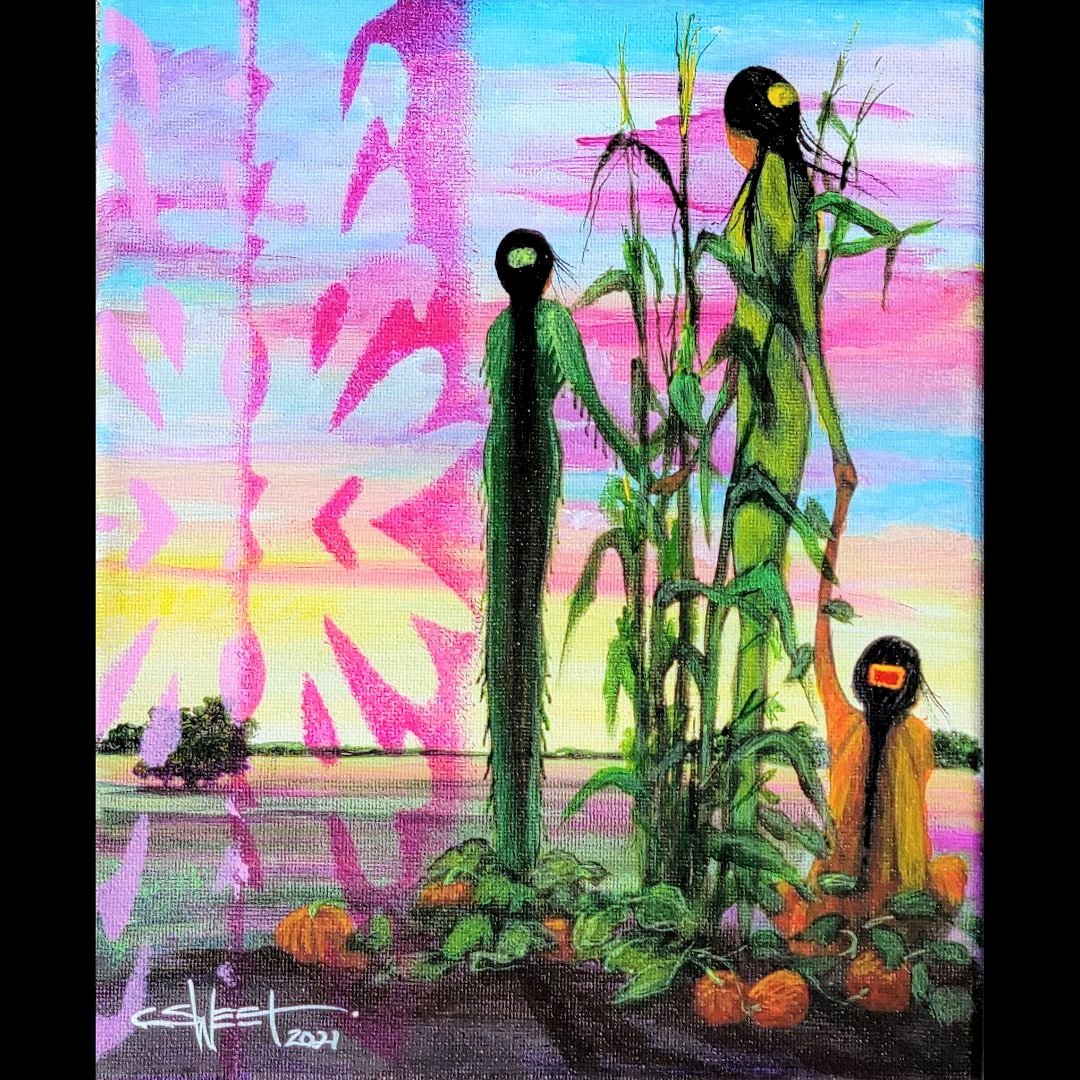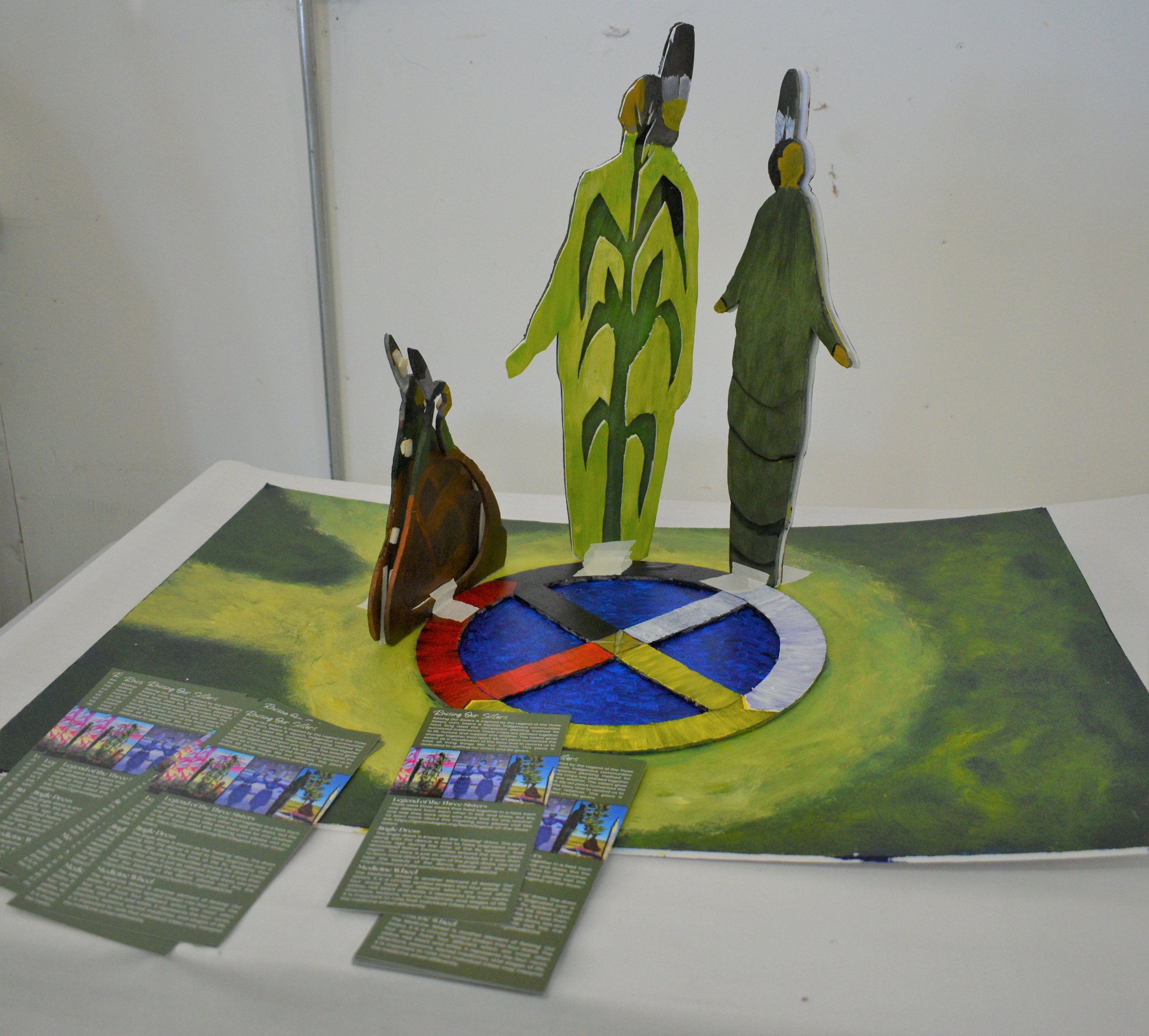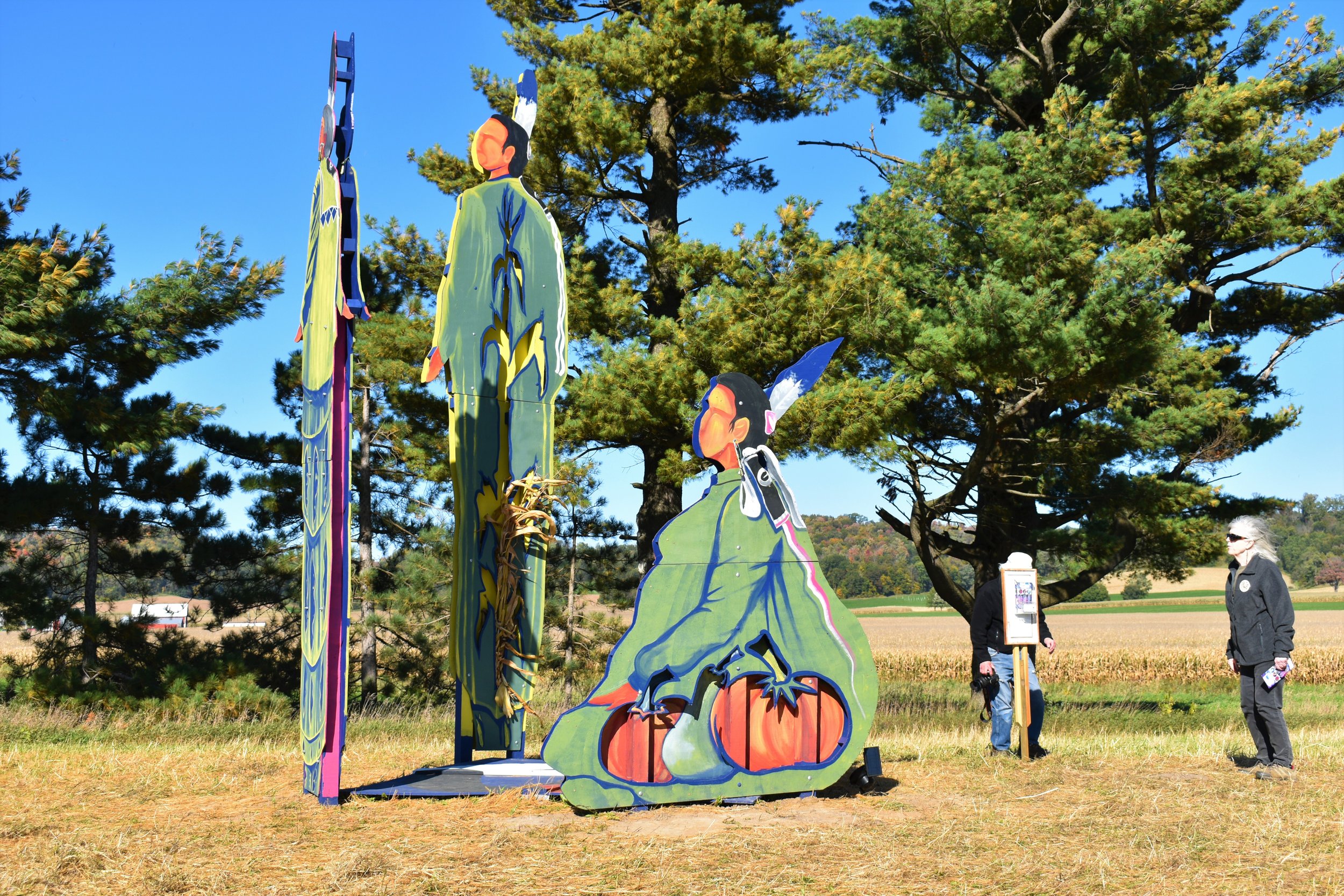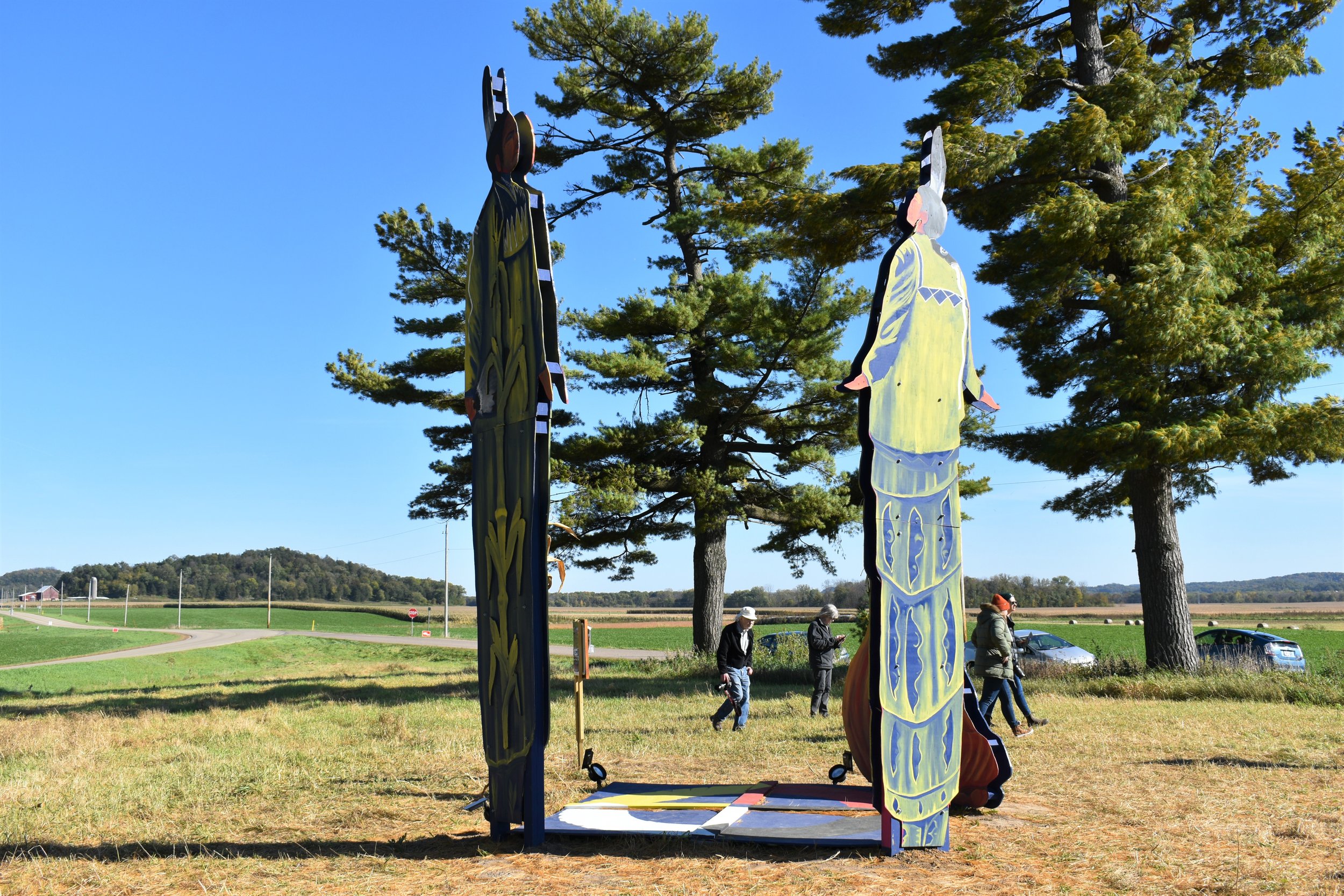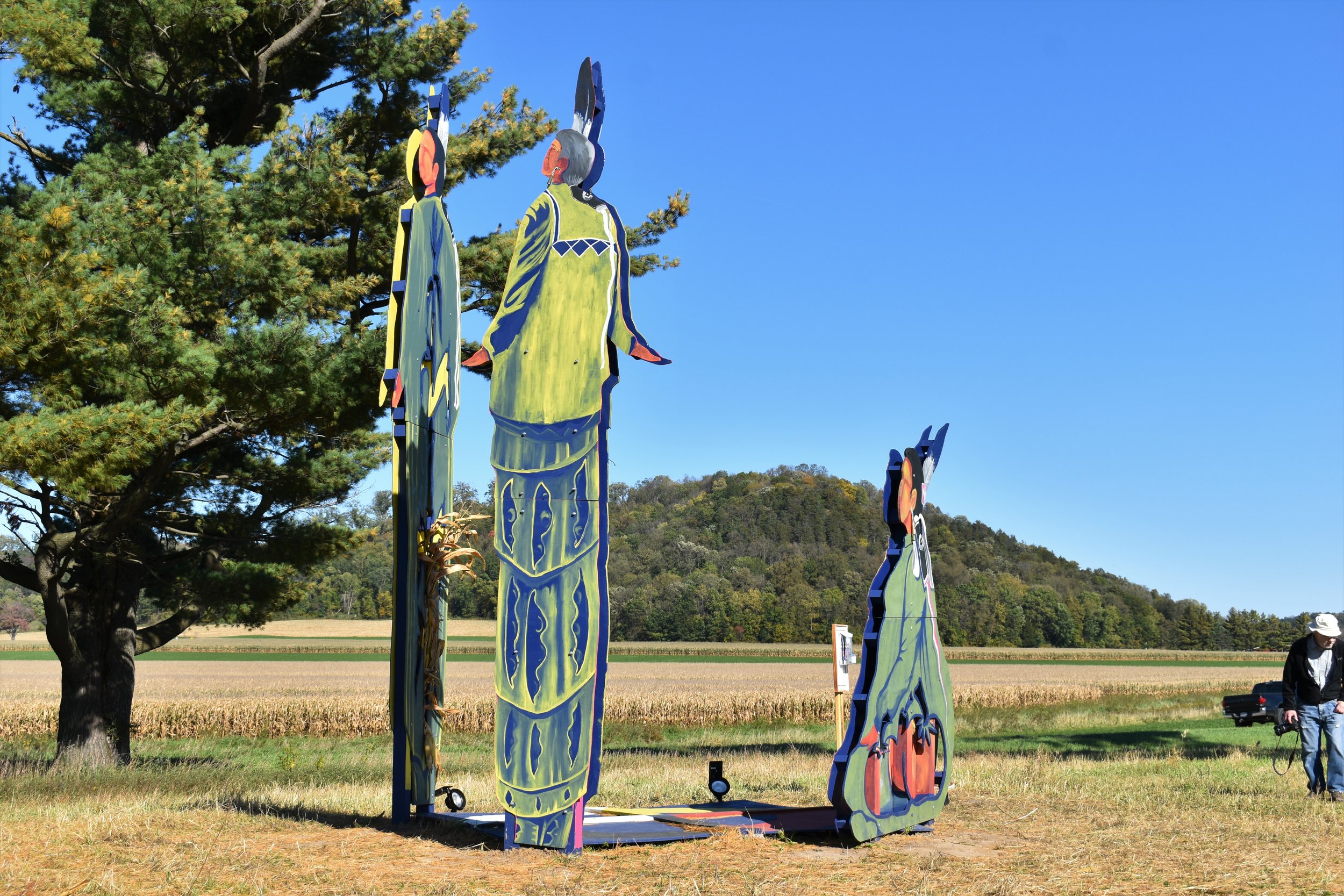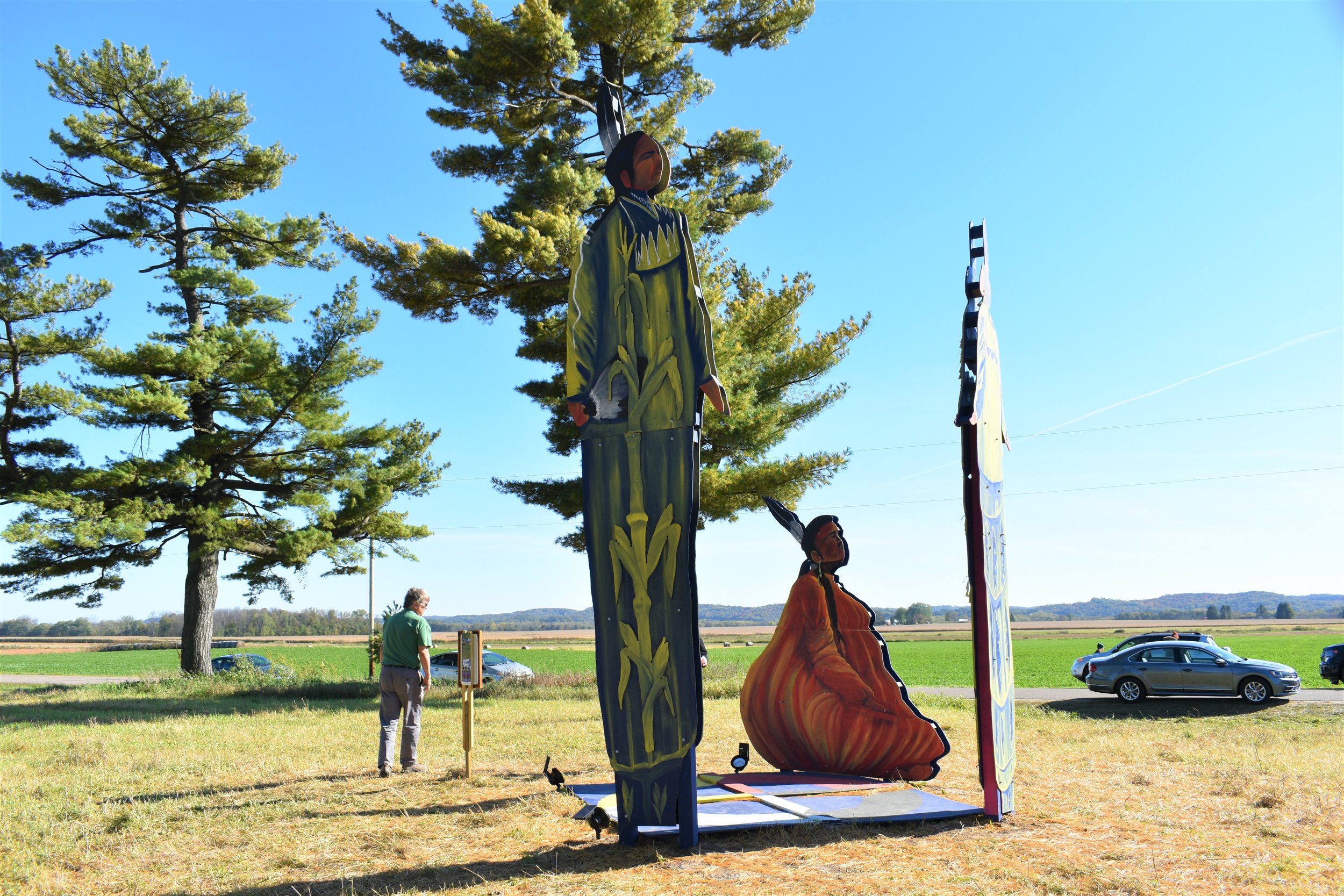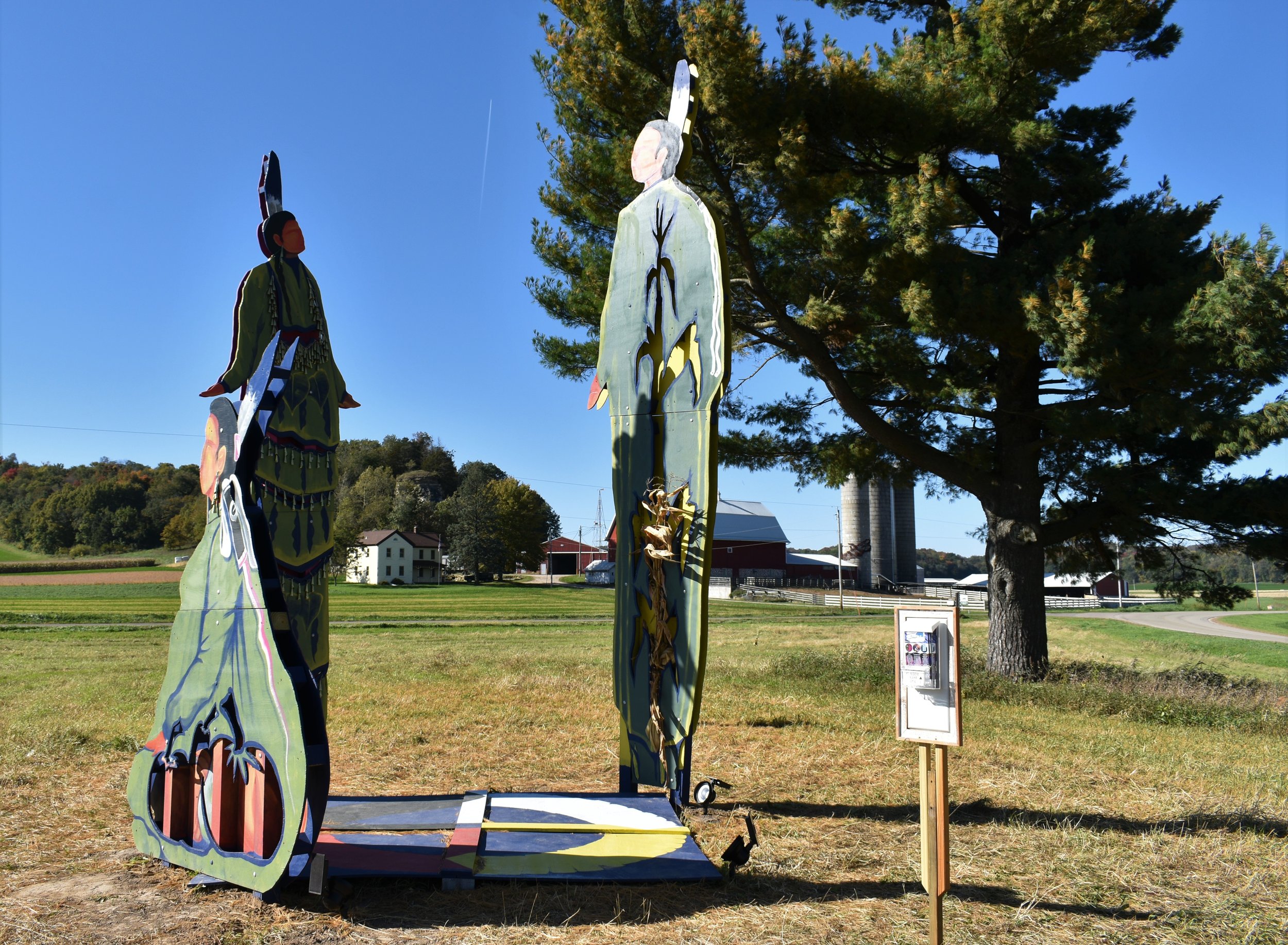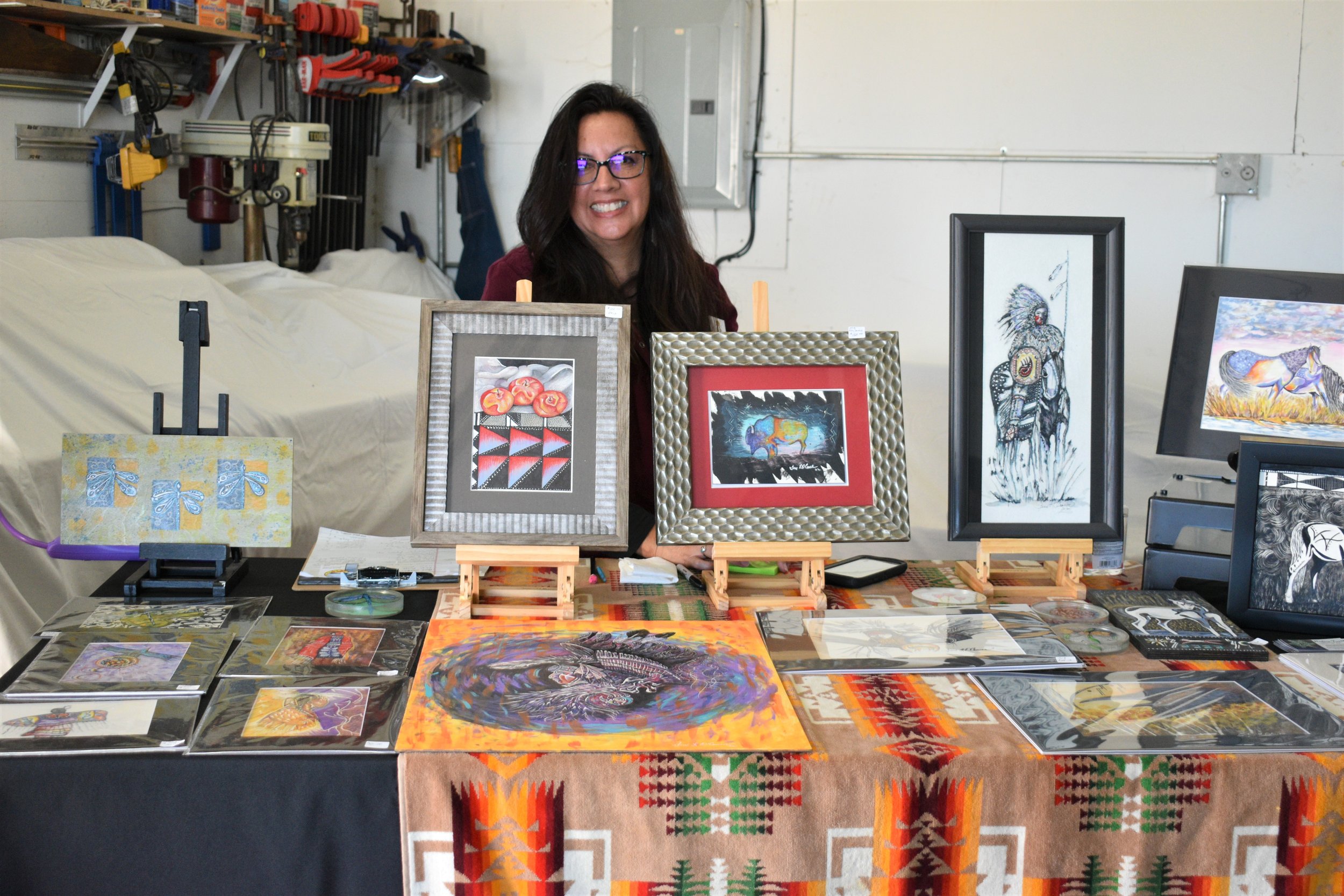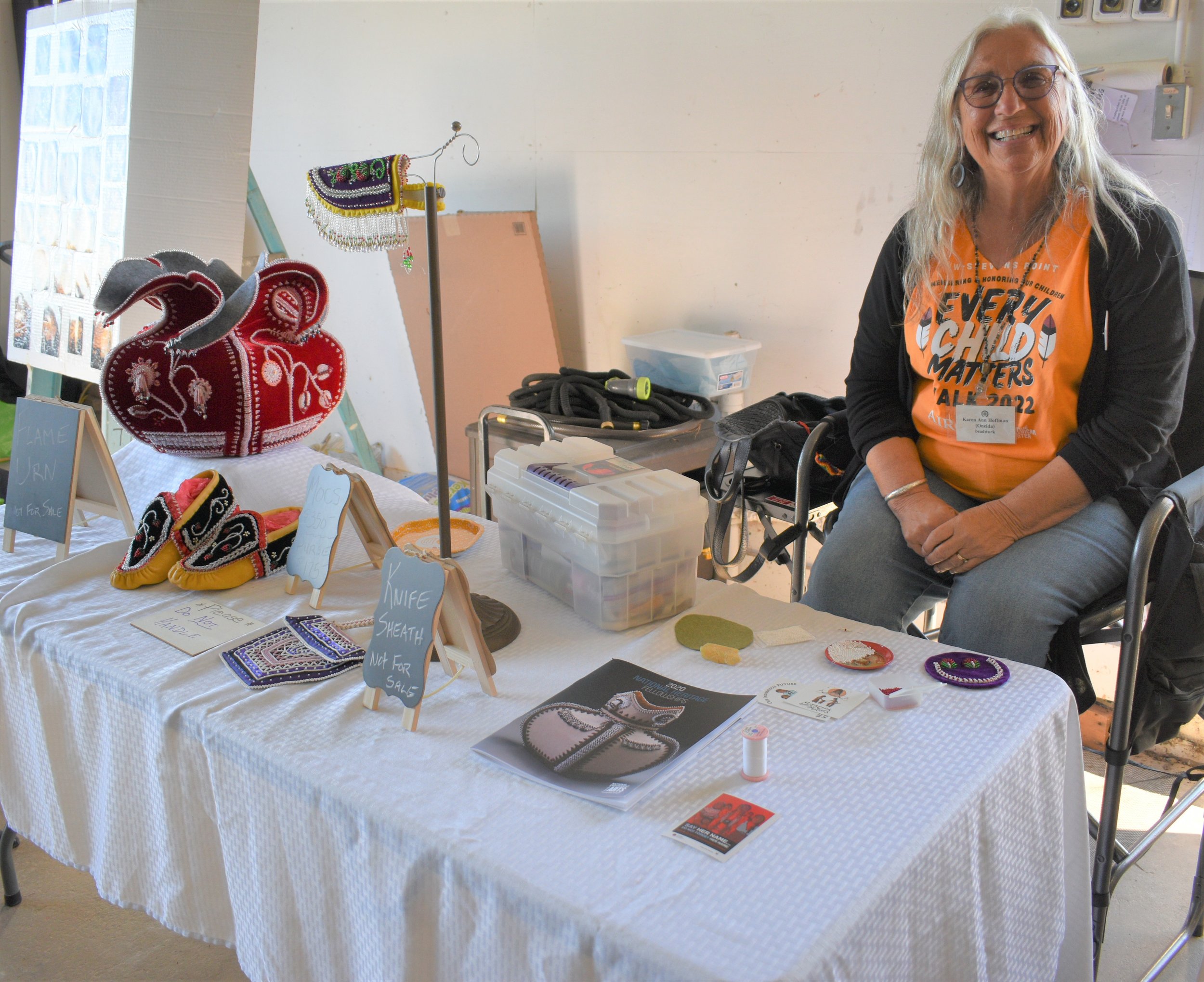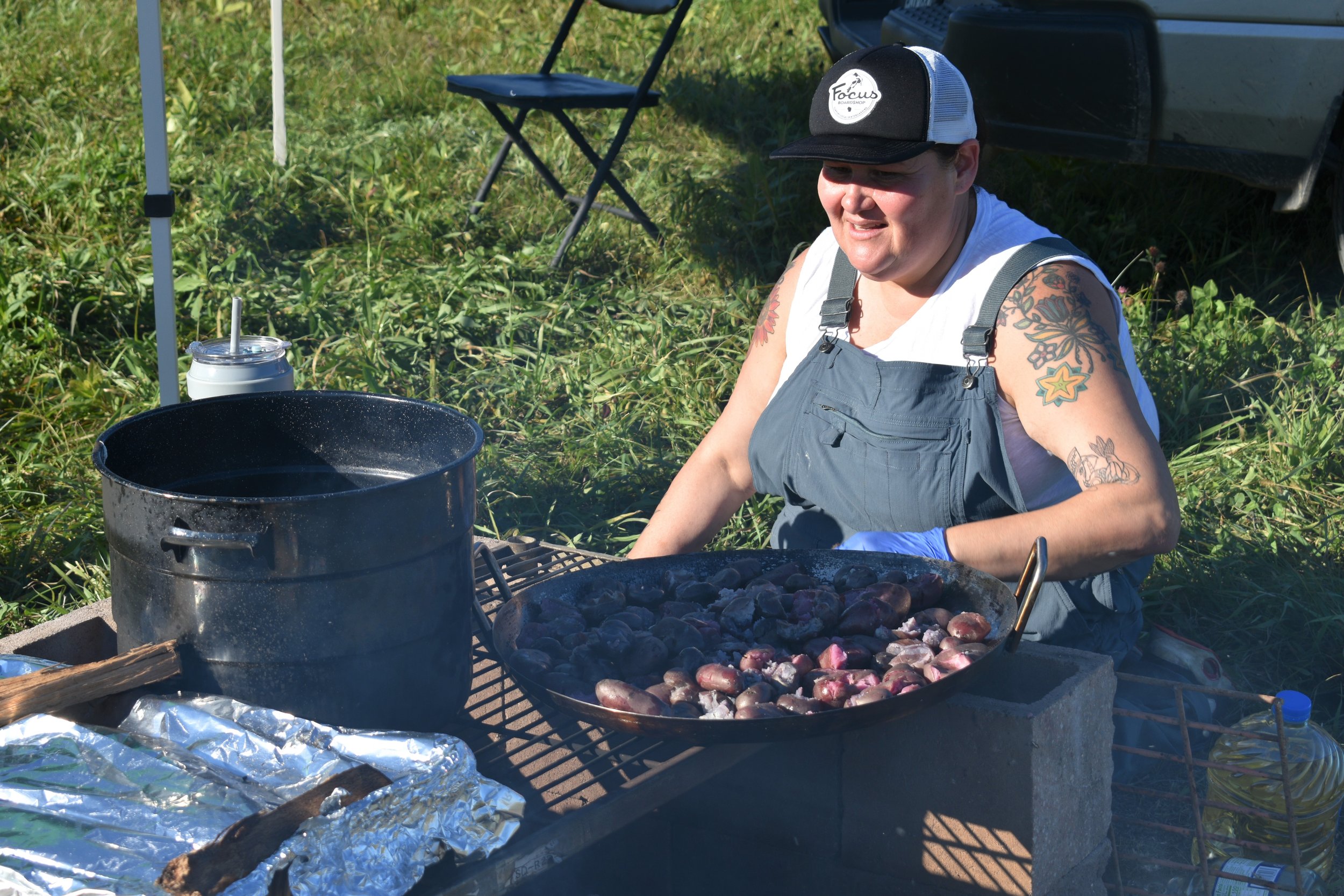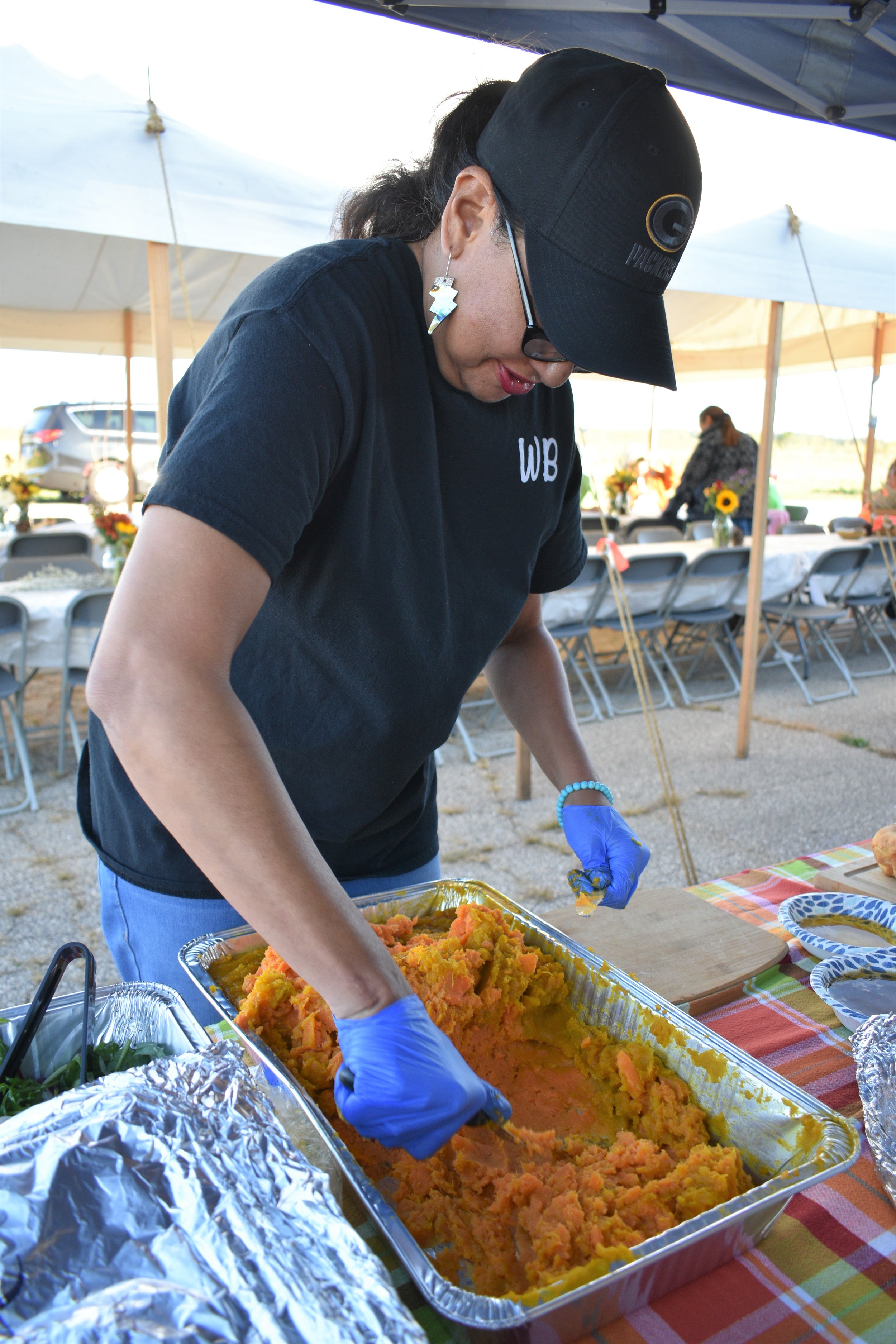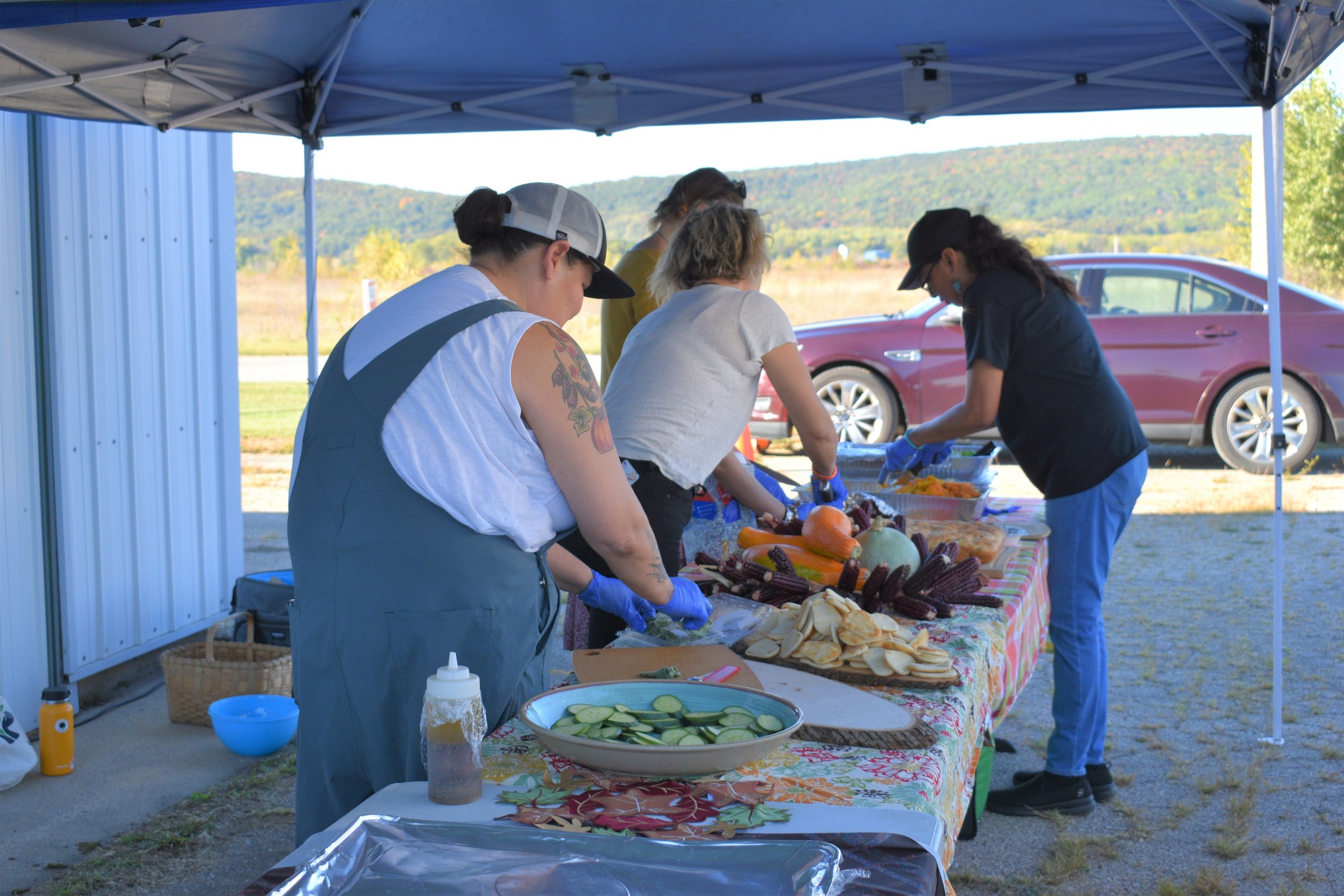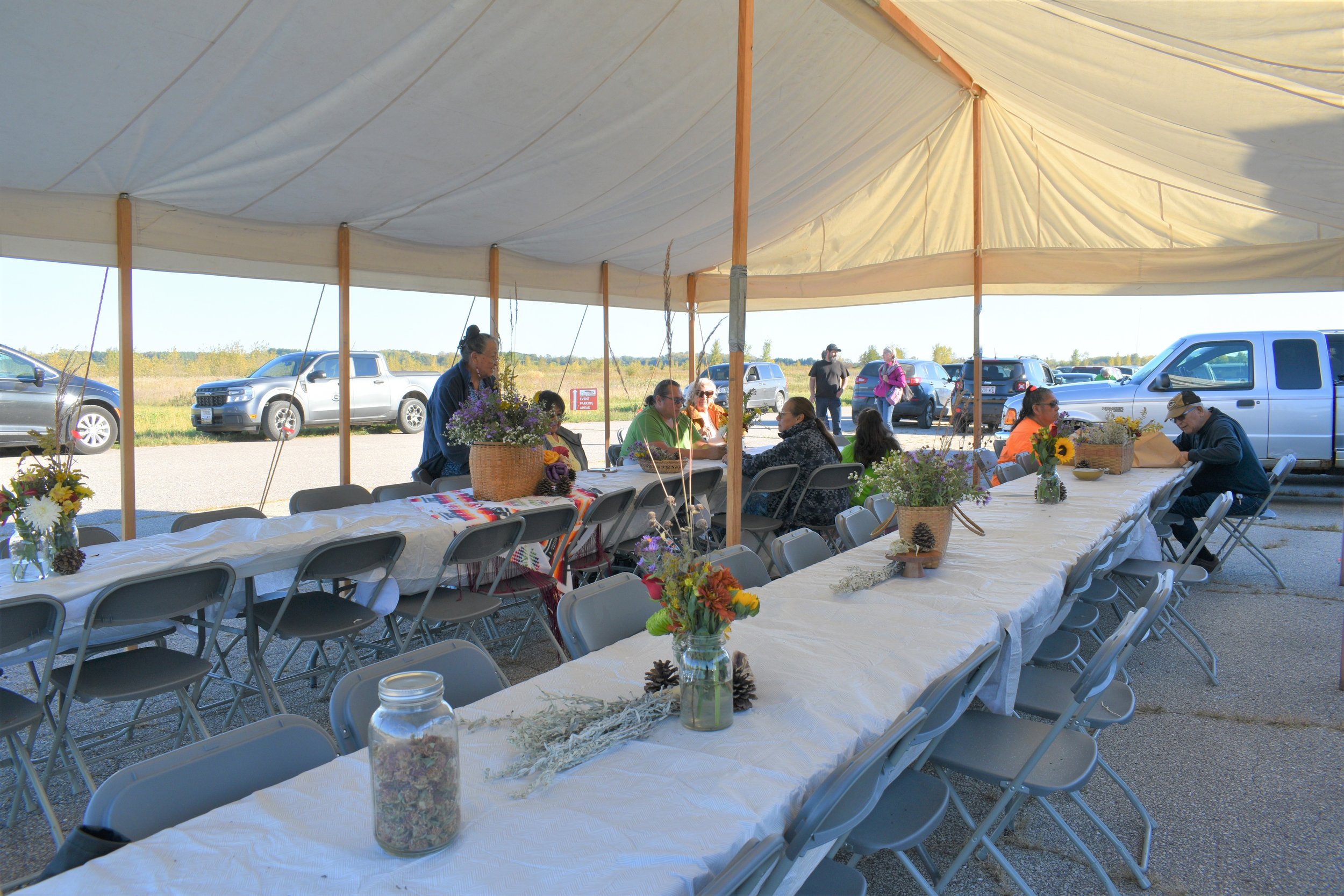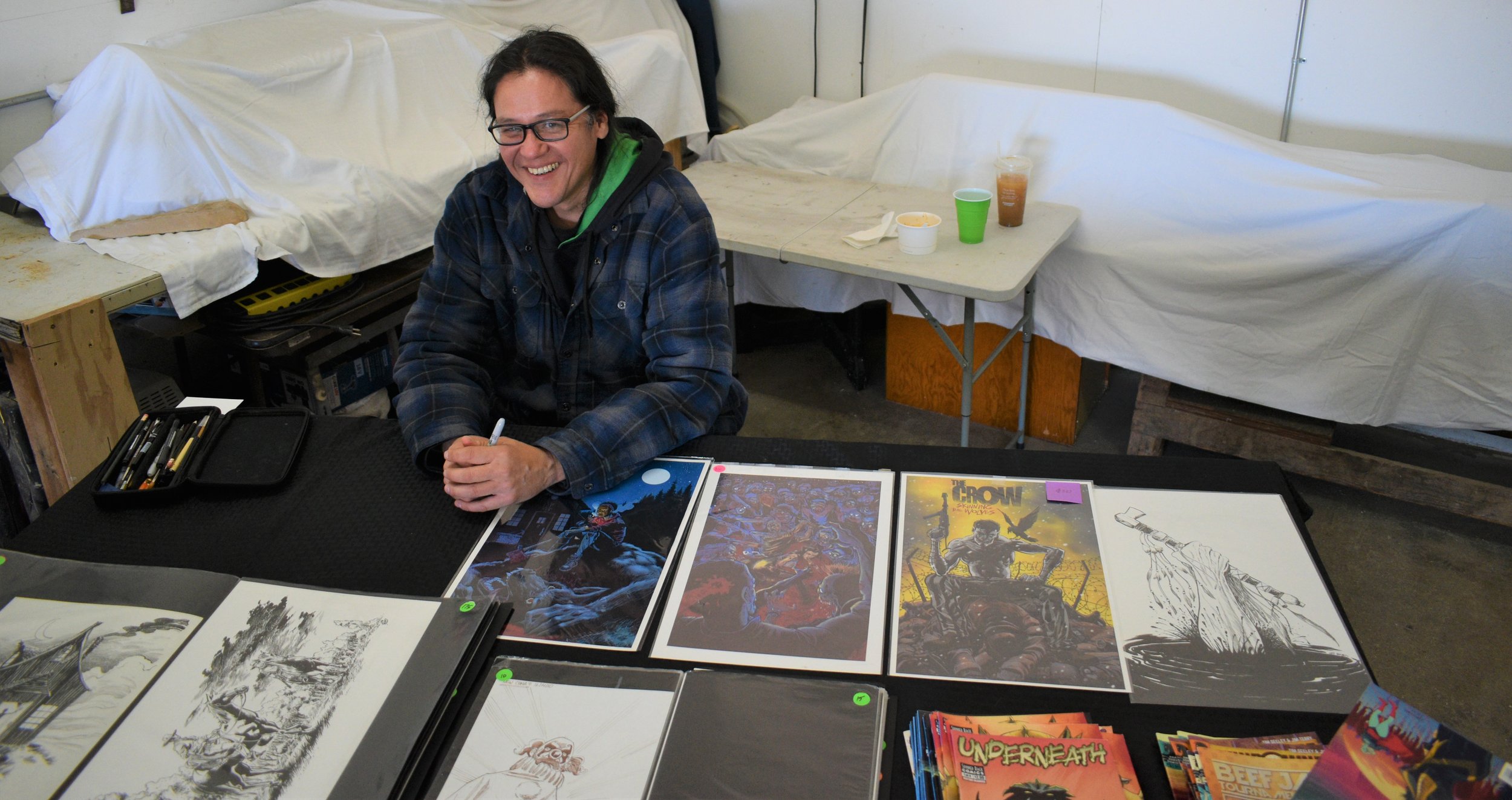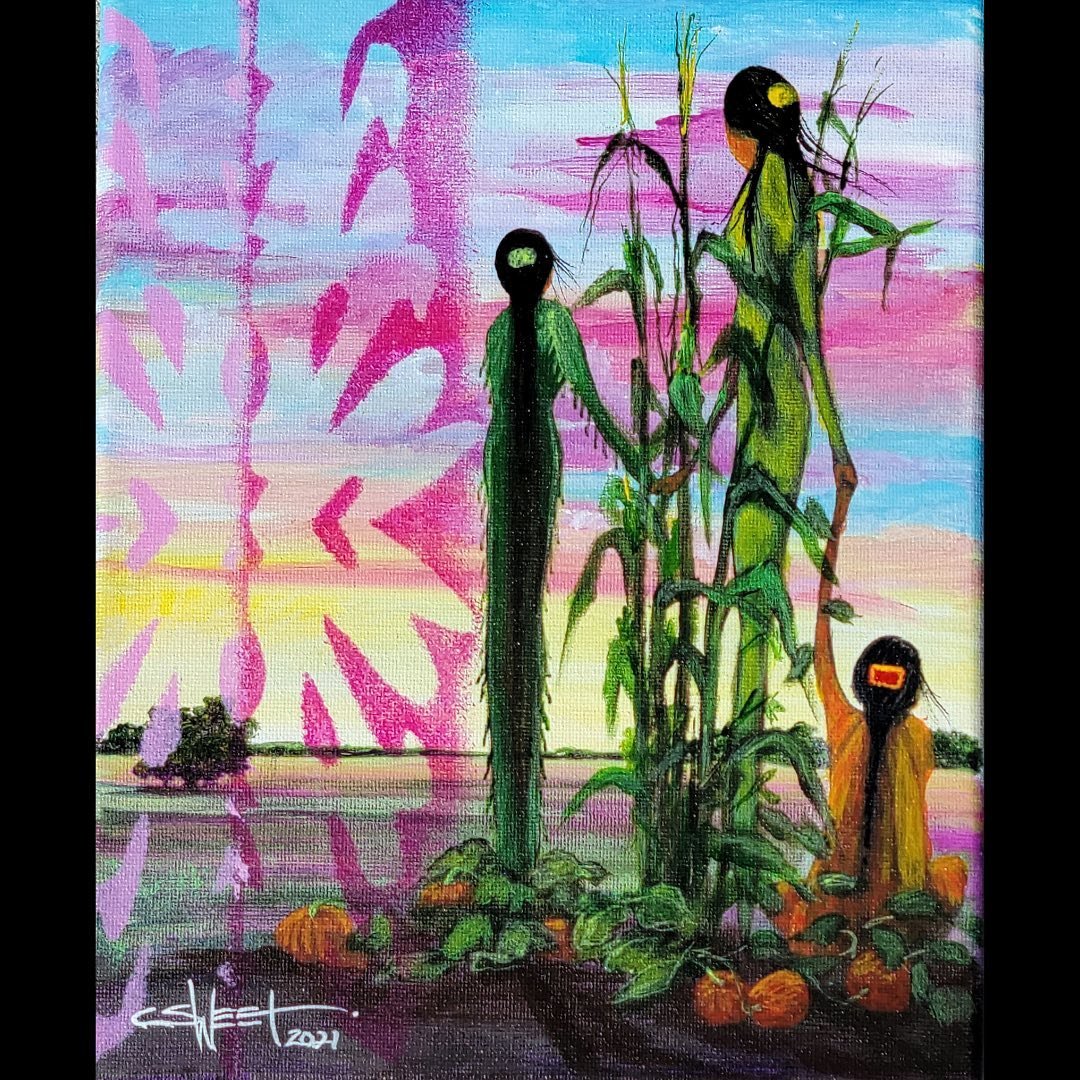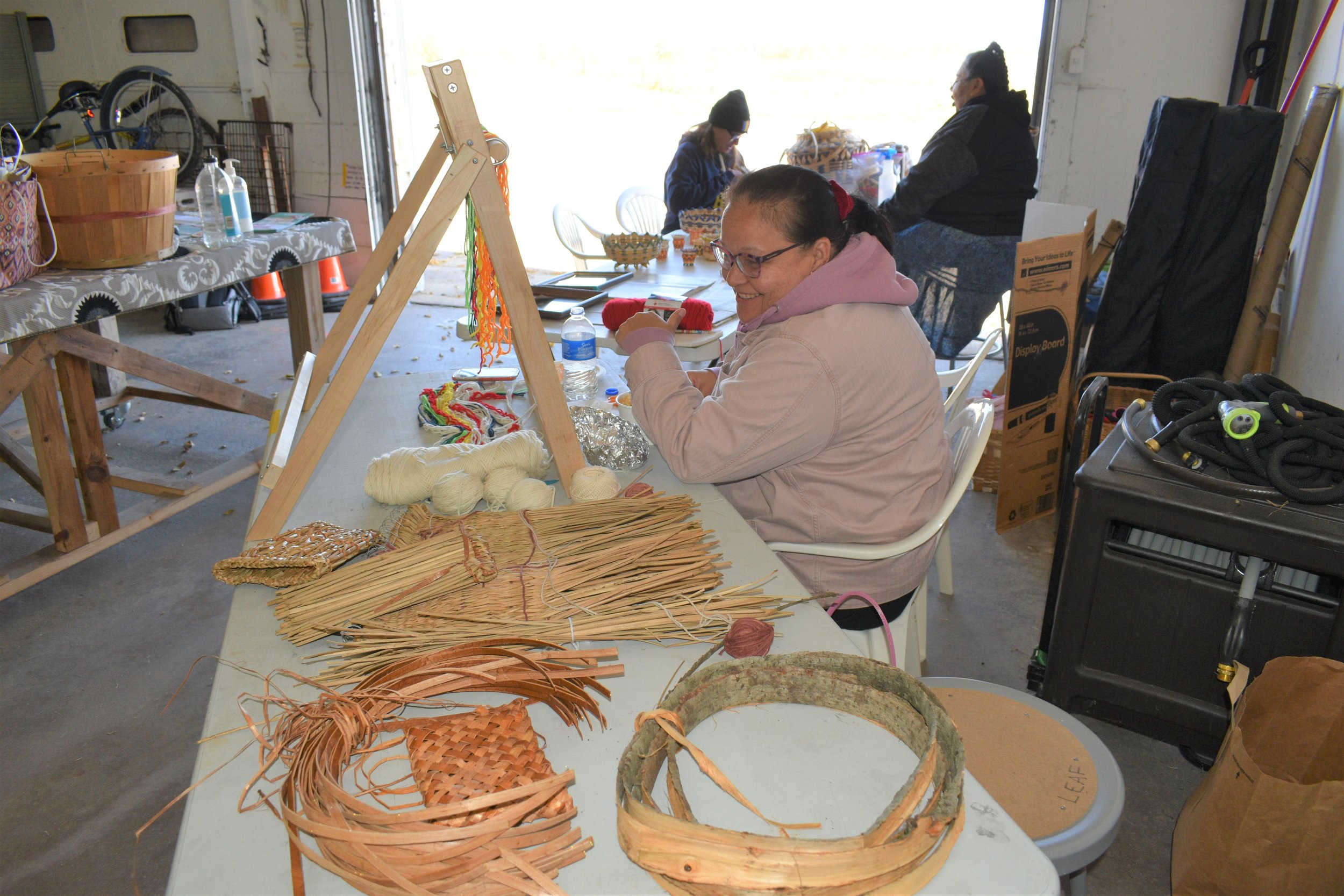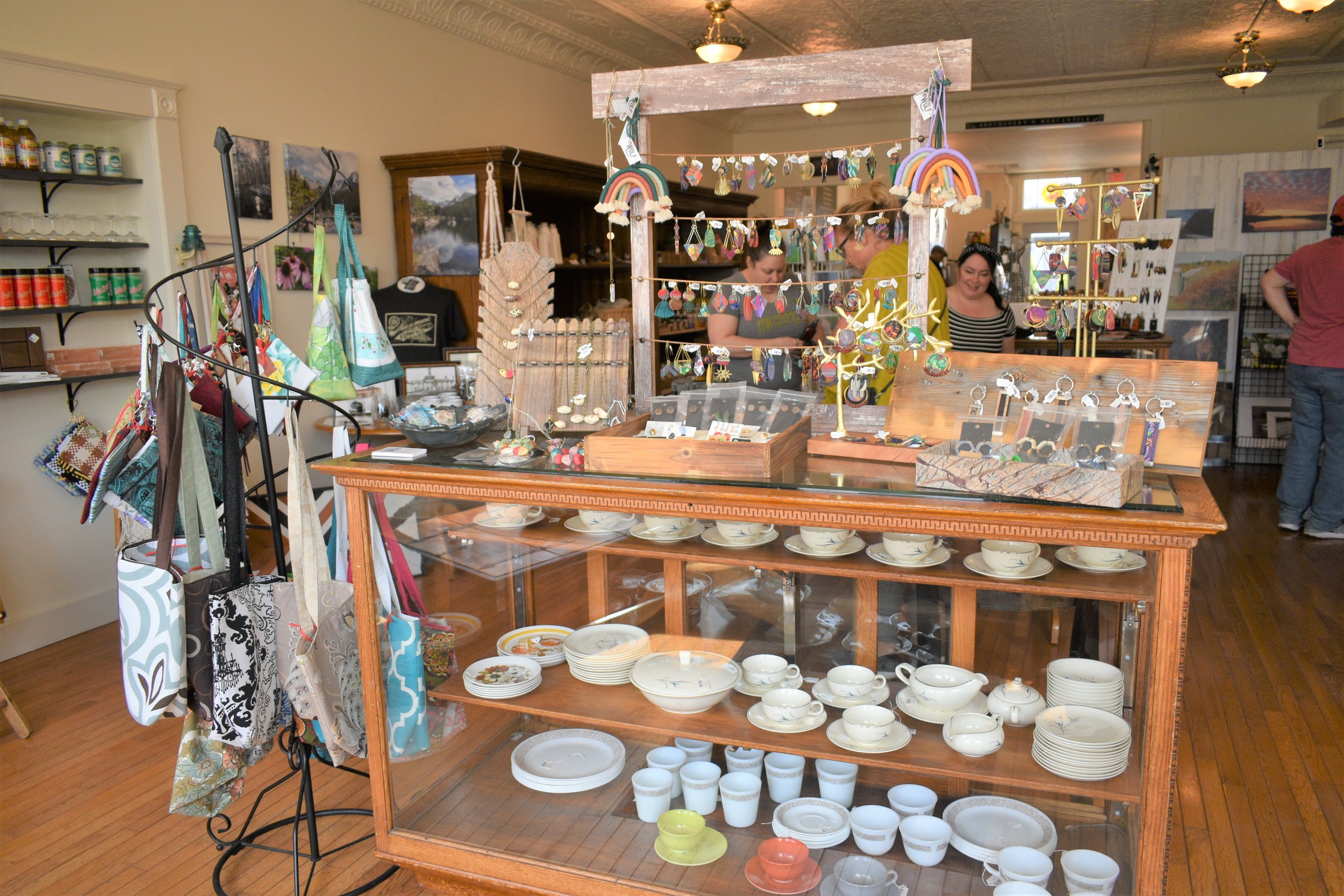Little Eagle Arts Foundation holds fall marketplace
An offshoot of Fermentation Fest and the Farm/Art Dtour in Sauk County, the Native American Art Marketplace featured authentic Native art, crafts, storytelling, and food over the first two weekends of October.
Held at the old Badger Ammunition plant in Sauk City, Wisconsin, the land was renamed Maa Wákąčąk (Holy land) by the Hoocąk (Ho-Chunk) when the tribe acquired it in a historic government to government transfer. The tribe has realized, for a lack of better terms, a cultural rebirth. Prairie and wildlife restoration have been in the forefront in the Hoocąk Nation’s plan for the property. In addition, Maa Wákąčąk hosts a cooperative art studio led by the Little Eagle Arts Foundation (LEAF).
“Fermentation fest is a big festival that's put on in Sauk County. I think it's happened for maybe 15 years or so,” said LEAF’s Hoocąk Founder and Director, Melanie Tallmadge-Sainz. “It used to be an annual thing, but I think COVID after shutting us down, they decided to make it biannual. It’s great, because the Fermentation Fest 50-mile tour is in Sauk County. It's always going to be somewhat close to our place here at Maa Wákąčąk. We're not on the tour but considered an offshoot.
This year’s Farm/Art Dtour featured seven artists commissioned to create art pieces for the 50-mile biennial tour, that meandered the backroads of Sauk County. LEAF’s own, Christopher Sweet was among the seven chosen, along with artists Austen Camille, Rosalynn Gingerich, Sarah Kavage, Bill Mitchell, Denise Rolland Troyer, and W. Scott Trimble. The seven were selected by a jury from a pool of more than 100 applicants. Sweet who also was present during the marketplace, created a larger-than-life piece that was placed just off a curve on Hwy PF, Southwest of Maa Wákąčąk. Titled “Raising Three Sisters”, Sweet said, “This piece is inspired by the legends of the three sisters, corn, beans and squash. Planted together to support, nurture and lift one another.” A previous piece Sweet painted called “Three Sisters”, inspired his Farm/Art DTour installation.
This year, LEAF’s Native American Arts Market The rooster of artists included; Karen Ann Hoffman (Oneida) Iroquois raised beadwork; Terri O'Connor (Stockbridge Munsee Band of Mohicans) acrylic and mixed media paintings; Menissa Powless and Ty Hopinkah (Hoocąk) beadwork and ribbon shirts; Christopher Sweet (Hoocąk /White Earth Ojibway) acrylic paintings, prints, and mixed media work; Leah Winneshiek (Hoocąk) jewelry; Kimberly Crowley (Hoocąk) black ash baskets; Leah LaMere (Hoocąk) jewelry; and Roxanne Johnson (Hoocąk) and Deanna Mead (Hoocąk /Menominee) beadwork, jewelry and clothing; Chef and Wild Bearies Founder Elena Terry (Hoocąk); Jim Terry (Hoocąk) published comic and graphic novel artist and illustrator, and Molli Pauliot (Hoocąk).
In addition, LEAF roster artist and Wild Bearies Lightning New Rider (Hoocąk) shared information about indigenous foods of the area and prepared indigenous foods that were available for purchase by visitors to the marketplace.
Hoocąk Chef Elena Terry and founder of Wild Bearies, an organization that is an educational, community outreach nonprofit that strives to bring ancestral foods to communities in a nurturing and nourishing way, was featured on October 1st. Tallmadge-Sainz said Terry was providing a beautiful harvest meal that evening. “She’s cooking outside here on site, and did some prep at her home in her kitchen.” Tallmadge-Sainz added they invited LEAF artists, family members, and people from the Rural-Urban FLOW, a coalition of artists and creative makers from Milwaukee, Madison, and Sauk County. “We've got a dozen or more folks from Milwaukee and Madison coming up here to join us for the meal. And we have some significant elders that have been a part of what we do, and it is a way to honor them. What better way to do it this time of year, than having a good Fall Harvest meal with all the wonderful abundance of product that we have?” Tallmadge-Sainz said LEAF’s mission is to provide economic development opportunities for their artists. “We couldn't do that without everyone in our community, because it takes a village right?”
Chef Terry noted, the Harvest Dinner is year three of what started as a friendship and has built into a strong inter-community relationship between Wild Bearies, the Worm Farm Institute (WFI organizer of the Fermentation Fest and the Farm/Art Dtour), and Alice's Urban Garden, all whom have contributed to a seat exchange that runs deep. “The meal is an extension of that work,” said Terry. “So, it's really an opportunity for us to feed our friends and our family in a way that we're honoring the harvest and the work that's been done. Some of the food that we have here was grown at the Worm Farm Institute this year. Some of it is ours. We also are honoring our farmers, foragers, growers, and producers. We have squash from the College of Menominee Nation and some squash from Dr. Becky Webster's homestead in Oneida, and some corn that they had given us. It's really exciting to be able to share in the feed from community, while really honoring what the growers are doing to responsibly grow our foods for us. This is an opportunity for me to feed them.”
Fellow Hoocąk Anne Thundercloud, a chef apprentice and Public Relations Manager with Wild Bearies, assisted Terry with the meal preparation. Involved with Wild Bearies since 2018, Thundercloud said she was interested in the food sovereignty movement, and recalled growing up as a child watching her gaga (grandmother in Hoocąk) foraging and gardening her own food. “I just thought it was great that you know, we could eat from things that my grandma had gathered or grown herself. And with our health issues, diabetes, obesity and heart disease being so prevalent amongst our people, I just figured that you know, obviously it has a strong tie with food and food as medicine. In some of our ceremonies, they say that the Creator gave us everything we need right here. I used to wonder like, well, where's all the medicine? How can I heal myself with my allergies and all these other problems that I have. I just started to learn more and more about it (Wild Bearies), and started out like you know, ‘I’ll help you serve food. I'll cut up some food for you,’ and just kind of started to go more and more with them.”
Eventually, Wild Bearies started a chef apprenticeship and Thundercloud jumped on the opportunity. She stressed the work is something she really enjoys.
Traveling with Wild Bearies to several different food sovereignty summits across the country, Thundercloud pointed out she has had the pleasure and honor to learn from many talented indigenous chefs like-minded in food sovereignty. “It's like, not even like work for me. I mean, well, yeah, physically, at the end of the day, that's when it starts to hurt, but it's a lot of fun,” she said with a smile.
Featured the following weekend, was Elena Terry’s brother, a published comic and graphic novel artist and illustrator, Jim Terry. Jim has published on his own several comic books, and has worked on other comic books the likes of The Crow and Sundowners among others. In 2020, Jim published his first book titled, “Come Home, Indio: A memoir”, with Street Noise Books in Brooklyn New York.
Jim started drawing at a very young age, an art that would become deeply woven into who he is as a human being. “It was always something that I did, something that I was drawn to. Growing up we didn't have a lot of money, but my mom always gave me pens and paper. Drawing has always been sort of been key to my identity, as a person just in general. I just happened to pursue it and keep going with it.”
When asked if he had any mentors, he responded, “I always had some uncles that were into comic books and would give me comic books and talk to me about them. As far as art, artistic mentors, it was just people whose books that I read, artists that I wanted to emulate and stories that I heard that were inspiring to me and made me want to be a storyteller.” As for as “practical mentors”, Jim said the regular things that you see and you experience growing up and watching adults and how they deal with things and trying to aspire to that or to change.
Jim acknowledged that his Native American roots have always played a deep-rooted role throughout his life and career. “I don't think there's any way that I could live my life and not have being Native a part of it.” Jim shared that he is not paid to draw stuff that is “native centric “, and that most of his work is for the masses. His personal expression in how he does his work though, is definitely informed by his cultural background. “The way that I look at the world in general is informed by that. It all goes through that filter. And that filter is definitely shaped by how I grew up, the people I've known in my life, and the paths that I've taken, good or bad.”
Jim expressed generally, that he considers himself a pretty private person who doesn’t share a lot about himself. While at Standing Rock during the Dakota Access Pipeline standoff for a short time, he met publisher Liz Frances that was following him on Instagram. “She was starting a publishing company, Street Noise Books based out of Brooklyn, New York, that focused on biopic and LGBTQ voices. She wanted to give marginalized voices a platform. And so, when she read about me on Instagram, she read that I was there and wanted to know more about me. But I wasn't comfortable being any kind of ambassador for that movement (Standing Rock) and anything that happened there. So, it turned into me telling my own story about how I ended up there. And that, of course, leads all the way back to you know, my parents and their parents and what leads anybody anywhere.” In talking about Jim writing a book, he said he was grateful Frances was generous enough to give him free rein on what he talked about, and how he approached things.
Jim said that he’s proud to be a part of it. It's not anything that he saw himself doing in life, writing and illustrating his own book. He said Frances pretty much had to convince him to do it. But is glad she did, as he has had people reach out to him and tell him his book was helpful to them. “That is the only reason to talk about yourself like that, in the hopes that it could be helpful to someone else.”
Admittedly, Jim said he was out of his comfort zone the entire time he worked on the book. “I usually like to just draw monsters and things like that. So, to dig into those cellars, and some of them are kind of dark, you know, was uncomfortable. If I was still in those places, it might have been impossible. Thankfully, I've navigated a lot of that, and being able to look back on it gives a different perspective, and in some cases, a kind of closure. It was a good thing for me to do for myself, and the fact that other people have said to me that it was helpful to them, is really what makes it worthwhile.”
